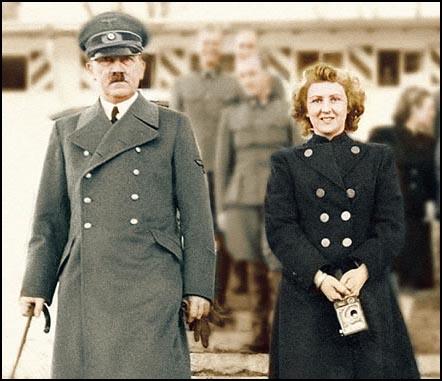Dictator Swagger:
On This Day
April 30, 1945 – Berlin, Germany: Nazi Fuhrer Adolf Hitler commits suicide in his Berlin Führerbunker with a gunshot to the head. He is joined in a suicide pact by wife of one day, Eva Braun, who simultaneously takes cyanide, which had been tested earlier on Hitler’s dog Blondi.
Adolf Hitler had ruled Nazi Germany since 1933 and started WWII with the 1939 invasion of Poland. Despite significant advances in the first half of the war, the opening of a second front in the East proved disastrous, and Hitler’s forces experienced a series of humiliating defeats, which drove their backs closer and closer to Berlin. Finally, on April 20, 1945, Hitler’s 56th birthday, Russian forces arrived on the outskirts of the German capital. Ten days later, Hitler would be dead, and on May 8, 1945, the war in Europe was over.
Did Hitler and Eva Braun actually commit suicide in the Führerbunker? How and when they died has been a source of controversy since WWII. Official history tells us that Hitler and his Frau died together on April 30, 1945, and were burned in a bomb crater immediately after in the garden of the Reich Chancellory. However, inconsistencies in the forensic and photographic evidence have lead historians to posit alternate theories as to the collective fate of Hitler and Braun.
The most popular theory is that the couple escaped with several other top Nazis in a U-boat packed with valuables to Argentina via Spain. In short, the theory, which is based on alleged sightings and anecdotal evidence, alleges that Hitler and his posse were protected by Juan Peron in Argentina. While living in Argentina, Hitler lived at several different compounds, separating from Eva Braun in 1954, and finally dying in obscurity in 1962.
The theory that Hilter escaped was fueled by the politicization of Hitler’s death by the Soviets. Though Hilter’s death was immediately announced by the Russians, Soviet premier Joseph Stalin told a former advisor to U.S. President Roosevelt that Hilter had lived. Stalin mainstreamed this theory in July 1945, when he said Hitler was living “in Spain or Argentina” at the Potsdam Conference. Another Soviet officer was quoted in the media as saying that the body found in the Chancellory garden was “a very poor double.”
Some sources have said that Stalin said this for political reasons to suggest that the Western powers were aiding Hitler in hiding. The claim, however, made its way into British and American newspapers through a variety of sources. Declassified documents have also shown that Western intelligence were taking seriously reports of Hitler living in South America well into the 1960s.
In 2009, the theory was given new life when a skull fragment thought to be Hilter’s, which was kept in the Moscow archives, was tested and found to have belonged to a female. That same year, Russian General Vasily Khristoforov of the Russian Federal Security Service revealed that the KGB, after burying, resuming and moving Hitler and Eva Braun’s remains several times, finally burned them and scattered the ashes in the Biederitz river in 1970. Opponents of the theory have pointed to the fact that Hitler’s dentist, as well as several expert teams, both positively identified jaw fragments found in the Chancellory garden as belonging to Hitler.


